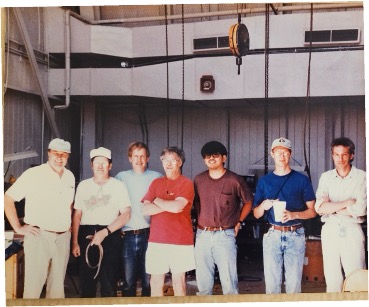
Dr. Robert A. Austin:
Shining a Light on the Cosmos: Purdue's Passionate Physics Lecturer
Story by David Siple
In the bustling corridors of the Physics Building at Purdue University, where groundbreaking research and transformative education intersect, Dr. Robert A. Austin, Ph.D., stands out as a luminous figure and a beacon of inspiration, curiosity, and unwavering dedication. As a Lecturer in Physics at Purdue, Austin brings a lifetime of intellectual passion, hands-on expertise, and enthusiasm to his classroom, turning the world of physics into an adventure for students and colleagues alike. Rooted in a childhood dream and nurtured by a lifelong love for the universe, he embodies the spirit of discovery that defines Purdue's academic community.
Austin's journey into the field of physics began at the age of eight, sparked by a historic moment that captured the world's attention: Purdue's most famous graduate, Neil Armstrong, taking his first steps on the moon. "I was eight years old when Neil Armstrong stepped on the moon, and watching that event unfold on television transformed my dream of becoming a scientist," explains Austin, recalling that summer night in 1969. That single experience laid the foundation for his lifelong pursuit of knowledge, which continued through high school as he took his initial steps toward a career in physics. "My early interest in space travel evolved into a desire to become a physicist when my eighth-grade English teacher "loaned" me his copy of Einstein: The Life and Times by Ronald W. Clark. I still have it on my bookshelf," says Austin.
Austin would then move on to the University of Chicago for the first two years of his collegiate career. He would then obtain a BS in physics at Purdue University. "I've known Purdue nearly all my life because I moved to Lafayette when I was four years old," says Austin. "Purdue has a strong physics department, and with its world-renowned engineering school, it draws a lot of highly motivated and intelligent students from around the world. The size of its campus is intimidating, but a benefit of its size is its extraordinary range of cultural offerings." Austin then served his country in the Navy and returned to Purdue to earn his MSc and PhD degrees in physics.
For Austin, the role of a Physics Lecturer at Purdue is not just a profession but a calling, offering a blend of freedom, mentorship, and joy that he finds deeply rewarding. "I enjoy a higher degree of autonomy than I ever experienced as a researcher, and I have the satisfaction of knowing that I am helping young people pursue their dreams," says Austin. "I get to think a lot about physics without the pressure of publishing papers, writing proposals, and attending conferences." But he cherishes the work-life balance his role offers, allowing him to pour his heart into teaching while maintaining a fulfilling personal life. "I usually get a good night's sleep. I can spend weekends at home, and I can take long vacations," adds Austin. In his words, his family is very happy to see him doing something he enjoys, and they feel he is having a positive impact on society.
At the heart of Austin's teaching is his commitment to making physics not only understandable but also engaging for his students. He engages in a dynamic, hands-on approach, using demonstrations and real-world analogies to spark curiosity and bridge the gap between abstract theories and everyday experiences. "I use demonstrations as much as possible to raise questions in students' minds about how the world works," he says. "If I am lucky, I can then lead them through the process of making a prediction and testing it with another demonstration. I also try to speak in terms of things students are familiar with, like skateboards, bicycles, cell phones, basketballs, etc.," He believes this method advances a deeper connection, transforming equations into vibrant, relatable ideas that resonate with students from all backgrounds.
Austin's rich research background further supplements his teaching, providing a unique perspective that bridges theory and real-world application. His expertise lies in the field of radiation detection, particularly for X-ray astronomy, medical imaging, and homeland security, with a specialization in high-pressure xenon-filled ionization detectors. His past work continues to inform his lectures, offering students a glimpse into the cutting-edge applications of physics that shape our understanding of the universe and improve society. "Just like using X-rays to peer inside the human body, astronomers can use X-rays to peer close to the source of their generation and study the hottest, most dynamic regions of these celestial objects. I designed and tested detectors that allow astronomers to study celestial objects using the X-rays they emit," says Austin.
His time at the Space Science Lab at NASA's Marshall Space Flight Center was one he will never forget. He spent part of his career at the intersection of groundbreaking science and visionary storytelling, but he's also had the rare privilege of witnessing history unfold. "I actually did witness a historical discovery firsthand," he says. "I was working in the same building as Gerald Fishman and the BATSE (Burst and Transient Source Experiment) team when they made their surprising discovery that gamma-ray bursts come from objects at cosmological distances."
While at Marshall Space Flight Center, he achieved what he considers his most significant scientific accomplishment: developing a prototype for the first hard X-ray imaging polarimeter. This groundbreaking work paved the way for instruments now operating in space. Most notably, the Imaging X-ray Polarimetry Explorer (IXPE), which is capturing the first-ever imaged polarization measurements of high-energy astrophysical sources, like black holes, neutron stars, pulsars, and gamma-ray bursts.
Austin, R.A.; Ramsey, B.D. Optical imaging chamber for X-ray astronomy. Opt. Eng. 1993, 32, 1990–1994.
As for the discoveries he wishes he could have seen unfold, "Of all scientific discoveries, I most wish I was working with Watson and Crick when they unraveled the structure of DNA." A moment that changed biology, it's a breakthrough that still captivates him today.

In late 2015, Austin wrote an award-winning article titled “Megatelescope Releases its First Image," which was featured in Physics Today in December 2016. The article describes the construction and first image release of the Asteroid Belt Astronomical Telescope (ABAT), a massive space-based observatory inspired by Purdue professor Andy Pillmaier's early 21st-century research. The project utilizes advanced quantum computing and powerful lasers to shape and align millions of mirror facets. Despite being only 1% complete, ABAT has already captured an unprecedentedly detailed image of the exoplanet Gliese 832 c.

The telescope's innovative "Devil's Footprint" shielding technique and self-replicating microscopic sensors ensure its effectiveness. Expected to be fully operational by 2216, ABAT represents a major leap in observational astronomy, with potential future expansions into the Kuiper Belt and beyond.
Austin's story is a testament to the power of curiosity and dedication. "I have wanted to be a scientist since I was in the first grade when I was asked to draw a picture showing what I wanted to be when I grew up. I drew a picture of a man in a lab coat holding a test tube over a flame. The title on the picture was "I want to be a scientist," says Austin. His journey from a wide-eyed child captivated by the moon landing to a beloved physics lecturer serves as an inspiration to all who cross his path.
Through his passion, mentorship, and innovative teaching methods, Austin continues to light the way for the next generation of physicists. From being a part of the Degrowth Study Group backed by Purdue’s Institute for a Sustainable Future, Austin’s legacy will ensure that the spirit of discovery burns brightly at Purdue University and beyond. When asked what advice he would give students considering a career in physics, Austin responded, "I would encourage them to become physicists only for the love of doing physics. Don't look at it as a career choice, consider it a vocation."
Austin stands as a shining example of what it means to be an educator, a researcher, a lifelong learner, and a Boilermaker. His legacy, built on a foundation of curiosity and connection, will undoubtedly inspire generations of Boilermakers to reach for the stars both literally and figuratively.